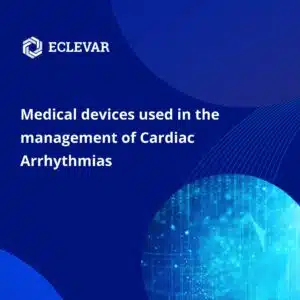The heart is a vital organ responsible for pumping blood throughout the body, ensuring oxygen and nutrients are delivered to and waste products are removed from cells. Cardiac arrhythmias, which are abnormal heart rhythms, can pose significant health risks and negatively impact a person’s quality of life. Cardiac Rhythm Management (CRM) devices have become an essential part of treatment for various heart disorders.
CRM devices include:
- Implantable pacemakers (IPGs) – These devices have been used for over 60 years to treat patients with slow heart rhythms (bradycardia). IPGs consist of electronic circuitry and a battery, which are implanted under the skin in the chest. The device is connected to the heart via pacing leads. More recently, leadless pacemakers have been developed for specific indications.
- Implantable Cardioverter Defibrillators (ICDs) – Introduced in 1980, ICDs have become more widely used with increasing clinical evidence demonstrating their life-saving capabilities. These devices detect and treat life-threatening fast heart rhythms originating in the ventricles (VT and VF) by delivering an electrical shock or fast cardiac pacing.
- Cardiac Resynchronization Therapy (CRT) – This treatment involves a dedicated pacemaker that improves the synchrony between the contractions of the right and left ventricles in heart failure patients with ventricular dyssynchrony. CRT can prolong life and improve the quality of life for these patients.
- Cardiac Ablation – This procedure involves changing the electrical properties of specific locations in the heart to eliminate the trigger of an arrhythmia or distort its conduction. Ablation is performed using radiofrequency or cryoablation catheters, and more recently, Pulsed Field Ablation (PFA) has been introduced.
In addition to these devices, 3D imaging systems (ElectroAnatomical Mapping, or EAM) are used to guide electrophysiologists during complex procedures, providing detailed information about catheter locations and cardiac rhythm patterns.
Regulatory agencies such as the European Medical Device Regulation (EU MDR) and the US Food and Drug Administration (FDA) classify medical devices into different classes based on patient risk and intended purpose. Implantable devices and ablation catheters fall under Class III (highest risk) and typically require clinical investigation evidence before market approval. EAM systems are categorized into Class II (a or b).
Post-Market Clinical Follow-up (PMCF) investigations are required in Europe to continuously demonstrate the safety and performance of medical devices.
Major manufacturers in the CRM device market include Medtronic, Abbott, Boston Scientific, and Biotronik. Some companies focus primarily on electrophysiology, such as Biosense Webster, Cardiofocus Adagio, Galvanize, Kardium, and Merit Medical.
Rapid advancements in CRM device technology, combined with increased requirements for clinical evidence under regulations like the EU MDR, have led to a growing demand for clinical studies in this field. This presents significant opportunities for manufacturers and clinical investigators to develop and validate innovative solutions for managing cardiac arrhythmias.

